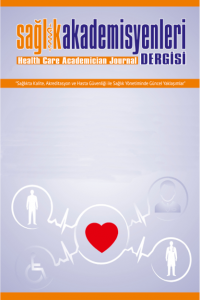OBSTETRİDE VE JİNEKOLOJİDE APİTERAPİNİN KULLANIMI
Apiterapi, Bal, Arı zehri, Jinekoloji, Obstetri
USAGE OF APITHERAPY IN OBSTETRIC AND GYNECOLOGY
Apitherapy, Honey, Bee venom, Gynecology, Obstetrics,
___
- 1. Hellner, M., Winter, D., von Georgi, R., & Münstedt, K. (2008). Apitherapy: usage and experience in german beekeepers. Evidence-Based Complementary and Alternative Medicine 5, 475-479.
- 2. Bălan, A., Moga, M. A., Dima, L., Toma, S., Elena Neculau, A., & Anastasiu C. V. (2020). Royal jelly-a traditional and natural remedy for postmenopausal symptoms and aging-related pathologies. Molecules, 25, 3291-3313.
- 3. Tekeoğlu, İ., Kaleli, S., & Akdoğan, M. (2016). Apiterapi ve arı zehiri akupunktur. Ankara Akupunktur ve Tamamlayıcı Tıp Dergisi, 4, 30-36.
- 4. Sorucu, A. (2019). Arı ürünleri ve apiterapi. Veteriner Farmakoloji ve Toksikoloji Derneği Bülteni, 10,1-15.
- 5. Ali, A. M., & Kunugi, H. (2020a). Apitherapy for Age-related skeletal muscle dysfunction (sarcopenia): A Review on the effects of royal jelly, propolis, and bee pollen. Foods, 9, 1362-1400.
- 6. Jagua-Gualdrón, A., Peña-Latorre, J. A., & Fernadez-Bernal, R. E. (2020). Apitherapy for osteoarthritis: Perspectives from basic research. Complementary Medicine Research, 27,184-192.
- 7. Ali, A. M., & Kunugi, H. (2020b). Apitherapy for parkinson's disease: A focus on the effects of propolis and royal jelly. Oxidative Medicine and Cellular Longevity, 17,1-18.
- 8. Niculescu, A. G., & Grumezescu, A. M. (2021). Natural compounds for preventing ear, nose, and throat-related oral infections. Plants, 10, 1847-1873.
- 9. Abedi, F., Ghasemi, S., Farkhondeh, T., Azimi-Nezhad, M., Shakibaei, M., & Samarghandian, S. (2021). Possible potential effects of honey and its main components against Covid-19 infection. Dose Response, 19,1-13.
- 10. Ali, A. M., & Kunugi, H. (2021). Propolis, bee honey, and their components protect against coronavirus disease 2019 (COVID-19): A review of ın silico, in vitro, and clinical studies. Molecules, 26,1232-1253.
- 11. Vandamme, L., Heyneman, A., Hoeksema, H., Verbelen, J., & Monstrey, S. (2013). Honey in modern wound care: A systematic review. Burns, 39, 1514-1525.
- 12. Weissenstein, A., Luchter, E., & Bittmann, S. (2014). Medical honey and its role in paediatric patients. British Journal of Nursing, 23, 30-34.
- 13. Kurek-Górecka, A., Górecki, M., Rzepecka-Stojko, A., Balwierz, R., & Stojko, J. (2020). Bee products in dermatology and skin care. Molecules, 25, 556-573.
- 14. Geleneksel ve Tamamlayıcı Tıp Uygulamaları Yönetmeliği (2014). Erişim adresi (08.03.2022): https://www.resmigazete.gov.tr/eskiler/2014/10/20141027-3-1.pdf
- 15. Ulusoy, E. (2012). Bal ve apiterapi. Uludağ Arıcılık Dergisi, 12, 89-97.
- 16. Al-Waili, N. S. (2004). Topical honey application vs. acyclovir for the treatment of recurrent herpes simplex lesions. Medical Science Monitor, 10, MT94-MT98.
- 17. Kamatou, G., Sandasi, M., Tankeu, S., Vuuren, S. V., & Viljoen, A. (2019). Headspace analysis and characterisation of South African propolis volatile compounds using GCxGC–ToF–MS. Revista Brasileira de Farmacognosia, 29, 351-357.
- 18. Yücel, B., Topal, E., Akçiçek, E., & Kösoğlu, M. (2014). Propolisin insan sağlığına etkileri. Anadolu Ege Tarımsal Araştırma Enstitüsü Dergisi, 24, 41-49.
- 19. Rivera-Yañez, N., Rivera-Yañez, C. R., Pozo-Molina, G., Méndez-Catalá, C.F., Reyes-Reali, J., Mendoza-Ramos, M. I., Méndez-Cruz, A. R., Nieto-Yañez, O. (2021). Effects of propolis on ınfectious diseases of medical relevance. Biology, 10, 428.
- 20. Ramanathan, A. N. K. G., Nair, A. J., & Sugunan, V. S. (2018). Arı sütü proteinleri ve peptitleri hakkında bir inceleme. Fonksiyonel Gıdalar Dergisi, 44, 255-264.
- ISSN: 2148-7472
- Yayın Aralığı: Yılda 4 Sayı
- Başlangıç: 2014
- Yayıncı: Dünya Kongre
OTOİMMÜN TİROİDİTİ OLAN HASTALARDA PREMATÜR OVARYAN YETMEZLİK SIKLIĞI
Ceren YILDIZ EREN, Hulusi Göktuğ GÜRER, Özlem ÖZGÜR GÜRSOY, Ozge GODEK
TOPLUMUN SAĞLIK ÇALIŞANLARINA YÖNELİK ŞİDDET KONUSUNDAKİ TUTUMU
Seda ÜNAL, Emel FİLİZ, Şeyma KAHVECİ, Sultan UYAR
Atikullah GHİASEE, Merve KARAKAŞ
PATOLOJİ LABORATUVARINDA MAKROSKOPİ TEKNİKERİNİN ROLÜ
Mustafa HÜZ, Kutsal YÖRÜKOĞLU, Nusret AKPOLAT
Sağlık Kurulunda Çalışanların İletişim Sorunları ve Çözüm Önerileri Üzerine Nitel Bir Araştırma
Nilay GEMLİK, Rukiye ŞEKER, Ali ARSLANOĞLU, Özgür ÇENGEL
Gelişmekte Olan Ülkelerin Sağlık Sistemi Göstergelerinin Karşılaştırmalı Analizi
Canser BOZ, Salim YILMAZ, Haluk ÖZSARI
Mansur Seymen SEĞMENOĞLU, Hilal KUŞCU KARATEPE
OBSTETRİDE VE JİNEKOLOJİDE APİTERAPİNİN KULLANIMI
Shaira . RAHİMJANOVA, Hüsniye DİNÇ, Sevil GÜNAYDIN
Sağlıkta “4P tıbbı”: Geleneksel tıp tarih mi oluyor?
Tuğçe ÇAMLICA, Fatma ETİ ASLAN
ÖDEME GÜÇLÜĞÜNE BAĞLI KARŞILANAMAYAN TIBBİ BAKIM İHTİYACI
Melek TERZİ, Mehmet Nurullah KURUTKAN, Dilek ŞAHİN, Oğuz KARA
